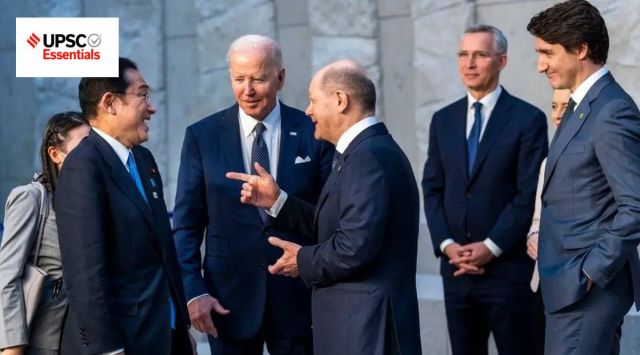- India
- International
UPSC Essentials: One word a day – NATO
What is NATO? Aspirants must know the term from not only prelims but also mains perspective. Know from basics to advance with Indian angle included for UPSC-CSE. Do not miss to solve the MCQ.
 The NATO was first established by the United States, Canada, and some other Western countries in 1949, in response to the perceived threat of the Soviet Union’s expansion in post-war Europe. (Image/The New York Times)
The NATO was first established by the United States, Canada, and some other Western countries in 1949, in response to the perceived threat of the Soviet Union’s expansion in post-war Europe. (Image/The New York Times)Take a look at the essential concepts, terms, and phenomena from the static and current parts of the UPSC-CSE. Also, check the answer to the previous MCQ.
Word: NATO
Subject: International Relations
Relevance: NATO is definitely important from prelims perspective because it is constantly in news. Moreover, the India angle is of great relevance from mains perspective too. This article covers the basics and the advance issues around the term. Highly productive for World History and International Relations in GS II. Read once and get it all. Also, do not miss solving MCQ.
Why in news?
— According to The Indian Express exclusive, away from public glare, New Delhi held its first political dialogue with the North Atlantic Treaty Organisation (NATO) in Brussels on December 12, 2019.
— Attended by senior officials including from the Ministry of External Affairs and the Ministry of Defence, it is learnt that the idea was to ensure that the dialogue was primarily political in character and to avoid making any commitment on military or other bilateral cooperation.
— Accordingly, the Indian delegation essentially attempted to assess cooperation on regional and global issues of mutual interest, The Indian Express has learnt.

— NATO, or the North Atlantic Treaty Organisation, was set up in 1949 by the US, Canada, and several western European nations to ensure their collective security against the Soviet Union. It was the US’s first peacetime military alliance outside the western hemisphere.
— The official website describes NATO as following:
1. NATO is a political military alliance: “Security in our daily lives is key to our well-being. NATO’s purpose is to guarantee the freedom and security of its members through political and military means.”
2. NATO is committed to collective defence: ” NATO is committed to the principle that an attack against one or several of its members is considered as an attack against all. This is the principle of collective defence, which is enshrined in Article 5 of the Washington Treaty.
— So far, Article 5 has been invoked once – in response to the 9/11 terrorist attacks in the United States in 2001.”
3. NATO has the Trans Atlantic link: NATO is an alliance of countries from Europe and North America. It provides a unique link between these two continents, enabling them to consult and cooperate in the field of defence and security, and conduct multinational crisis-management operations together.
— Thirty countries are members of NATO currently. NATO is headquartered in Brussels, Belgium. The headquarters of the Allied Command Operations is near Mons, also in Belgium.
What is Article 5 of the North Atlantic Treaty?
—Article 5 reads:
“The Parties agree that an armed attack against one or more of them in Europe or North America shall be considered an attack against them all and consequently they agree that, if such an armed attack occurs, each of them, in exercise of the right of individual or collective self-defence recognized by Article 51 of the Charter of the United Nations, will assist the Party or Parties so attacked by taking forthwith, individually and in concert with the other Parties, such action as it deems necessary, including the use of armed force, to restore and maintain the security of the North Atlantic area.”
How did NATO originate? What was the rationale behind NATO?
— At the end of WW II, as battered European nations started to rebuild their economies, the US, which believed that an economically strong, re-armed, and integrated Europe was critical to prevent the westward expansion of communist USSR, embarked on a programme to supply economic aid to the continent on a massive scale.
— The European Recovery Programme, known as the Marshall Plan after President Harry S Truman’s Secretary of State George C Marshall, promoted the idea of shared interests and cooperation between the US and Europe.
— The USSR declined to participate in the Marshall Plan, and discouraged eastern European states in its sphere of influence from receiving American economic assistance.
— In the 1946-49 Greek Civil War, the US and UK worked to thwart the Soviet-backed communist takeover of Greece.
— The Western nations threw their weight behind Turkey as it stood up to Soviet pressure over control of the Bosporus and Dardanelles Strait (which connect the Black Sea and Sea of Marmara and the Sea of Marmara and Aegean Sea respectively) — and in 1947-48, the US committed itself to containing the communist uprisings in Turkey and Greece.
— In 1948, Stalin’s government sponsored a coup in (erstwhile) Czechoslovakia, which led to the installation of a communist regime in a country sharing borders with both Soviet-controlled East Germany and the pro-West West Germany.
— In 1948-49, the Soviets blockaded West Berlin to force the US, UK, and France to give up their post-war jurisdictions in the country, leading to a major crisis and an 11-month airlift of supplies by Western countries to keep their part of the city going.
— All these events led the US to conclude that an American-European alliance against the USSR was necessary.
— The Europeans too were convinced of the need for a collective security solution, and in March 1948, the UK, France, Belgium, Netherlands and Luxembourg signed the Brussels Treaty of collective defence, which meant that if any of the signatories faced an attack, they would be defended by all the others.
— A few months later, the US Congress passed the Vandenburg Resolution, a landmark action “advising the President to seek US and free world security through support of mutual defence arrangements that operated within the UN Charter but outside the Security Council, where the Soviet veto would thwart collective defence arrangements”.
— The Vandenburg Resolution was the stepping stone to NATO. The US believed the treaty would be more effective if it included, apart from the signatories of the Brussels Treaty, countries of the North Atlantic — Canada, Iceland, Denmark, Norway, Ireland, and Portugal.
— From the American perspective, these countries were the links between the two shores of the Atlantic Ocean, and could help facilitate military action if it was needed.
— The treaty was signed in Washington DC on April 4, 1949. It had 12 signatories initially: the US, UK, Canada, France, Denmark, Belgium, Norway, Portugal, the Netherlands, Italy, Iceland, and Luxembourg.
— Greece and Turkey were admitted in 1952, and the Federal Republic of Germany (West Germany) in 1955. Spain joined in 1982, and in 1999, a decade after the collapse of the USSR, the former Soviet bloc countries of Czech Republic, Hungary, and Poland became part of NATO.
— Bulgaria, Estonia, Latvia, Lithuania, Romania, Slovakia, and Slovenia joined in 2004, Albania and Croatia in 2009, Montenegro in 2017, and North Macedonia in 2020, taking the membership of the alliance to 30.
Why Russia Vs NATO?
— Hostility to the USSR was the reason NATO came into being, and in 1955, the Soviet Union signed its own collective defence treaty, known as the Warsaw Pact, with seven eastern European countries — Poland, Czechoslovakia, Albania, Bulgaria, East Germany, Hungary, and Romania.
— The Warsaw Pact collapsed with the end of the Cold War, and was formally declared disbanded in February 1991. Among its signatories, the USSR, Czechoslovakia, and East Germany no longer exist, and the remaining five countries are part of NATO.
— Barring a brief period after the collapse of the Soviet Union, Russia under Putin has been suspicious and insecure about the West. The three Baltic states, now part of NATO, share borders with Russia, and only Belarus and Ukraine among the countries that were once in its sphere of influence are now outside of the western military alliance.
— From the perspective of the Kremlin, keeping a buffer between NATO and Russia along its southern and western border is critical to its security. A hostile Ukraine, protected by NATO’s nuclear umbrella, could potentially have missile launchpads within a few hundred kilometres of Moscow, and cut off Russia’s access to the warm water ports of the Black Sea — it was in part to pre-empt this eventuality that Russia annexed Crimea in 2014.
What are the three alliance of NATO?
— Euro-Atlantic Partnership Council (EAPC) is a 50-nation multilateral forum for dialogue and consultation on political and security-related issues among Allies and partner countries.
— Mediterranean Dialogue is a partnership forum that aims to contribute to security and stability in NATO’s Mediterranean and North African neighbourhood.
— Istanbul Cooperation Initiative (ICI) is a partnership that aims at long-term global and regional security by offering non-NATO countries in the broader Middle East region the opportunity to cooperate with NATO.
Why India’s talk with NATO is significant?
— India’s talks with NATO hold significance given that the North Atlantic alliance has been engaging both China and Pakistan in bilateral dialogue. There was a view here that given the role of Beijing and Islamabad in New Delhi’s strategic imperatives, reaching out to NATO would add a key dimension to India’s growing engagement with US and Europe.
— The government, sources said, was of the view that engaging NATO in a political dialogue would provide New Delhi an opportunity to bring about a balance in NATO’s perceptions about the situation in regions and issues of concerns to India.
— In NATO’s view, India, given its geo-strategic position and unique perspectives on various issues, was relevant to international security and can be an important partner in informing the alliance about India’s own region and beyond, the sources said.
— The first dialogue, it is learnt, revealed three critical issues on which India expected only limited common ground with NATO:
i) from NATO’s perspective, it was not China, but Russia whose aggressive actions, continued to be the main threat to Euro-Atlantic security, and that NATO had faced difficulties to convene meetings of NATO-Russia Council due to Russian refusal to place issues such as Ukraine and Intermediate-Range Nuclear Forces Treaty, on the agenda.
ii) Given the divergence among NATO countries, its view on China was seen as mixed; while it did deliberate on China’s rise, the conclusion was that China presented both a challenge and an opportunity.
iii) in Afghanistan, NATO saw the Taliban as a political entity, which was not in line with India’s stance. This was almost two years before the Taliban announced an interim government in Afghanistan in September 2021.
— However, the Indian side felt maritime security as a principal area of conversation in the future, given a substantial common ground with NATO.
What else you should know?
— Spanish Foreign Minister José Manuel Albares: ‘NATO must reach out to all countries like India which might be good partners’.
— Ahead of the NATO summit in Madrid on June 28, visiting Spanish Foreign Minister José Manuel Albares on Wednesday said that NATO (North Atlantic Treaty Organisation), which traditionally only looked towards the eastern flank, must also look to the southern flank, and reach out to all those countries that like India, might be good partners, and interested in keeping stability in the world.
— In an exclusive interview to The Indian Express, Albares – who met External Affairs Minister S Jaishankar – when asked about possible discussions between India and the NATO, said, “It is not for me to decide, it is up to the UN Secretary General to decide that. But of course, a dialogue, certainly between NATO and India, is most welcome.”
(Sources: nato.int)
MCQ:
Consider the following statements and answer the question below:
1. Spain and Italy are not the members of NATO.
2. Article 5 of NATO has been invoked only once.
3. NATO was US’s first peacetime military alliance outside the western hemisphere.
Which statements are correct?
a) 1 and 2 b) 2 and 3
c) 1 and 3 d) only 3
Answer to the previous MCQ: UPSC Essentials: One word a day – PESA (b)
Apr 26: Latest News
- 01
- 02
- 03
- 04
- 05








































